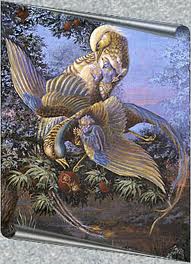MUNDAKA UPANISHAD
By U. Ve. , MahAmahOpAdhyaya, Dr. Sriman Srirangam Nallan Chakravarthy Raghunathacharya Swami: Translated into English by Sriman K.S. Rajaji I.A.S.,
Saanti Mantram
Before this Upanishad is studied or learnt the custom is invocation is done by the following Mantras before embarking on to the main Upanishad.
Mantra-1
Bhadram karNebhih s¡¦ruNuyAma devAh
Bhadram pas¡¦yemAkshabhir yajathrAh|
Sthirairangai sthushtuvAgm sasthanUbhih
Vyasema devahitham yadAyuh||
The substance of the Mantra : O Gods! May we always listen the auspicious Vedas. May we always perform the Yajnas and watch always auspicious things. May we always be possessed of strong bodies with firm and strong limbs. May we always recite the hymns praising you, and have longevity so as to render auspicious things to you.
Mantra-2
Svasthi na indro vriddhas¡¦ravAh
Svasthi nah pUshA vis¡¦vavedAh|
Svasthi nasthArkshyO arishtanemih
Svasthi no brihaspathirdadhAthu||
The substance of the mantra ¡V May Indra, who is well renowned confer on us good fortune! May the all-knowing Sun confer on us good fortune. May Brihaspati confer on us good fortune!
Aum s¡¦Anthih s¡¦Anthih s¡¦Anthih.
May the threefold worries : aadhyathmika, aadhibhauthika and aadhidaivika abate and we live in peace.
SrimathE rAmAnujAya namah
Mundakopanishat
(based on the Ramanuja dars¡¦anam)ƒn
Muraripu padayuga nakhara- jyOthis¡¦chandrAthapAnubhavathripthA|
Hrishyathu chiththachakOree ¡V visrijya samsArasamudithAyAsAn||
sathpramANa bahuyukthivis¡¦eshaih ¡V lakshmaNArya paridrishtasaraNyA|
AndhravAgbhiradhunA vis¡¦adAbhih mundakopanishadam vivriNeemah
The origin of the Upanishad
The Mundakopanishat is part of the AtharvaNa Veda. It consists of six parts called Khandas. The Upanishad consists of three divisions, each of which is divided into two parts or Khandas. The Ramanuja¡¦s tradition takes into account of six Khandas without resorting to the divisions and Khandas. But Sri S¡¦ankara had considered the divisions and the Khandas. In Sri S¡¦ankara¡¦s commentary, there are 65 mantras. In the Ramanuja¡¦s tradition, in Sruthaprakaasika and in the discussions thereon we find some additional manthras in the adris¡¦yathva section and also some differences in the readings. Upanishadbhashyakarar Sri RangarAmAnuja Muni in his Bhavaprakasika had commented on 65 manthras but in his commentary in the first Khanda he had included one mantra ¡V yasmAthparam na aparamasthi…, only as extra. It is not clear as to the reason for not making commentary on these extras in the UpanishadbhAshya, but making commentary in Bhavaprakasika on the extra stanzas. Thus in the commentary of RangarAmAnuja there are 66 manthras as against S¡¦ankara¡¦s commentary showing 65 manthras. This is to be discussed at the appropriate places as the commentary proceeds.
Since the Upanishad establishes in a concise form the five essential topics which a seeker has to know, the pUrvAchAryAs had observed that this Upanishad establishes these five topics much more comprehensively than the other Upanishads.
These five topics are named – the Arthapanchaka ¡V as a group. They are illustrated in the following verse of HAreetha samhita¡V
prApyasya BrahmaNo rUpam, prApthuscha pratyagAthmanah
prApthyupAyam phalam prApthesthaththA prApthivirodhischa|
vadanthi sakala vedAh sethihAsapurANakAh
munayascha mahAthmAnah vedavedAnthinah||
Meaning ¡V
prApyasya of the sought after
BrahmaNo rUpam, Brahman¡¦s characteristics
prApthuh of the seeker ¡V (the JivA)
pratyagAthmanah cha the JivA
prApthyupAyam the means of attaining the sought after Brahman
prAptheh phalam the benefit of the attaining the sought after fruit
thathhA Like wise,
prApthivirodhis’cha| the obstructions while following the means to achieve the
sought after
sakala vedAh all the Vedas,
ithihAsapurANakAh the persons who are thorough with Ramayana,
Mahabharata, Vishnu PurANa etc
vedavedAnthinah the persons who have studied Vedas and Upanishads etc
mahAthmAnah the persons of impeccable personality as per Vedic
Traditions)
Munayascha the persons who have Him as the single subject of their
thoughts.
Vadanthi say that the above five are the topics a person must know.
The substance is that the five topics which one must know are :
1) The real nature of the Brahman, who is the cause for the entire universe and who is sought to be attained by the JivA;
2) The nature of JivA, who is seeking to attain the Brahman;
3) The nature of means to attain the Brahman;
4) The fruit, the eternal Bliss, which the JivA attains in the presence of Brahman; and
5) Finally the obstacles one faces in his process of following the means stated above, to attain the sought after.
These above five topics are elaborated in this Mundakopanishat, in various mantras.
In this Upanishad, the Supreme God-head is called as Akshara, and the nature of worship needed to attain Him is explained. To indicate that this Akshara VidyA is a very precious one and that this is the Brahmavidya followed by the seekers, having a good behaviour, the essence is being told in a story to make it interesting to learn and practice.
In our next posting we shall start with the Mantras of the Upanishad and the beautiful commentary of Sriman MahAmahOpAdhyaya Dr. Raghunathacharya
Courtesy– Srinivasa Ramanujadasan
to be continued …









